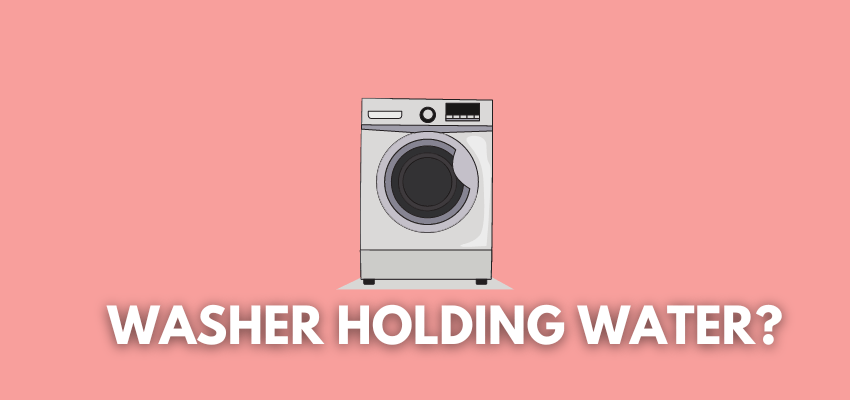Table of Contents
Last Updated on: 30th July 2023, 12:31 pm
Everyone likes smooth-running washing machines, and the moment they start to create trouble for users, they start thinking about replacing them with new ones.
If your washing machine is holding water and not draining properly, it can be frustrating and inconvenient. There are several potential reasons for this issue, ranging from simple clogs to more complex mechanical problems.
Understanding the possible causes can help you troubleshoot and resolve the problem effectively.
| Disclaimer: As an Amazon Associate, I earn from qualifying purchases. |
Reasons Why a Washing Machine Holds Water
Let’s take a look:
Clogged Drain Hose
A common cause of a washing machine holding water is a clogged drain hose. Over time, lint, debris, or even small objects like coins or hairpins can accumulate and block the hose.
Inspect the drain hose for any obstructions and remove them if possible. Consider using a pipe cleaner or a gentle stream of water to clear out any residue.
Blocked or Malfunctioning Pump
The pump in your washing machine is responsible for draining water from the tub. If it becomes blocked or malfunctions, water may accumulate and remain in the machine.
Check the pump for any clogs or foreign objects. In some cases, the pump may need to be repaired or replaced by a professional.
Faulty Lid Switch
A faulty lid switch can prevent the washing machine from entering the spin or drain cycle, leading to water accumulation. The lid switch is a safety feature that detects if the lid is closed.
If it is not functioning correctly, the machine may not proceed with draining the water. Consult the manufacturer’s instructions or a technician to diagnose and fix the lid switch issue.
Clogged or Malfunctioning Water Level Sensor
The water level sensor, also known as the pressure switch, determines the appropriate water level for each cycle. If it is clogged or malfunctioning, the machine may not drain properly.
Inspect the sensor and clean any debris that may be affecting its function. If cleaning doesn’t resolve the issue, the sensor may need to be replaced.
Drainage System Issues
Problems with the drainage system itself can also cause water to be held in the washing machine. A faulty or incorrectly installed drain pipe, a blocked plumbing vent, or a clogged sewer line can restrict water flow and result in drainage problems.
Consider contacting a plumber to inspect and address any drainage system issues.
Malfunctioning Timer or Control Board
The timer or control board in your washing machine controls various functions, including the draining cycle. If it malfunctions or develops a fault, it can prevent the machine from draining properly.
Check for any error codes or unusual behavior on the control panel. If necessary, consult a professional for further diagnosis and repair.
Let’s Conclude
When your washing machine holds water and doesn’t drain properly, it can be indicative of underlying issues that need attention.
Check for clogged drain hoses or pumps, faulty lid switches or water level sensors, drainage system problems, or malfunctioning timers or control boards.
While you can attempt basic troubleshooting, it’s advisable to consult a professional technician if the problem persists or if you’re uncertain about performing repairs yourself.
Promptly addressing the issue will ensure that your washing machine functions optimally and prevents water accumulation in future wash cycles.
How do I get rid of standing water in my washing machine?
Sure, here are the steps on how to get rid of standing water in your washing machine:
Check the lid switch
The lid switch is a safety mechanism that prevents the washing machine from draining if the lid is open. Make sure that the lid is closed tightly before you try to drain the machine.
Run a spin cycle
If the lid switch is working properly, running a spin cycle may be enough to clear the standing water. This will help to dislodge any clogs that may be preventing the water from draining.
Check the drain hose
The drain hose is the hose that carries water from the washing machine to the drainpipe. If the hose is kinked or clogged, it will prevent the water from draining properly.
To check the drain hose, disconnect it from the washing machine and run water through it. If the water does not flow freely, you will need to clear the clog.
Clean the drain pump filter
The drain pump filter is a small filter that catches lint and other debris that can clog the drain. To clean the filter, remove it from the washing machine and rinse it under warm water.
Call a Professional
If you have tried all of the above steps and the standing water is still there, you may need to call a professional. There may be a more serious problem with your washing machine that requires professional repair.
How do you manually drain water from a washing machine?
To manually drain water from a washing machine, follow these steps:
- Unplug the washing machine to ensure safety.
- Locate the drainage hose, usually positioned at the back or side of the machine. It is typically connected to the drain pump.
- Place a shallow container, such as a bucket or large basin, beneath the drainage hose to catch the water.
- Carefully detach the drainage hose from the drain pump or the standpipe it is connected to. Be prepared for some water to spill out initially.
- Allow the water to flow into the container until it stops. You may need to lift the drainage hose higher or lower to control the water flow.
- Once the water has drained completely, reattach the drainage hose securely to the drain pump or standpipe.
- Plug in the washing machine and run a short spin cycle to ensure that the drainage system is functioning properly.
Note: It is essential to consult the manufacturer’s manual for specific instructions regarding your washing machine model, as the drainage process may vary slightly.
If manually draining the water does not resolve the issue, it may indicate a more significant problem with the washing machine. Consider contacting a professional technician for further inspection and repairs.






